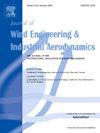阻力长度是量化树冠阻力的关键
IF 4.2
2区 工程技术
Q1 ENGINEERING, CIVIL
Journal of Wind Engineering and Industrial Aerodynamics
Pub Date : 2025-03-23
DOI:10.1016/j.jweia.2025.106084
引用次数: 0
摘要
树木对城市流量的影响通常在计算流体动力学模拟中确定,使用基于叶面积密度a和体积阻力系数CdV的二次阻力公式。我们建立了植被冠层内流动的解析模型,并确定了阻力长度d=(aCdV)−1作为描述局部树木阻力的关键度量,它代表了由于树木阻力导致的冠层内平均速度的调整长度尺度。一项详细的文献调查表明,在田间试验中观测到的中位数d为树木21 m,低植被(作物)为0.7 m。共进行了168次大涡模拟,得到了解析模型的封闭形式,可以从典型的阻力系数Cd和气动孔隙度αL的风洞实验中确定a和CdV。我们证明了几何尺度的d是风洞中树木的合适尺度。文献中对数值模拟和风洞实验(假设几何比例尺为1:100)的评估表明,在这两种情况下,中位数d约为5 m,这表明可能高估了植物阻力。本文章由计算机程序翻译,如有差异,请以英文原文为准。

The drag length is key to quantifying tree canopy drag
The effects of trees on urban flows are often determined in computational fluid dynamics simulations using a quadratic drag formulation based on the leaf-area density and a volumetric drag coefficient . We develop an analytical model for the flow within a vegetation canopy and identify the drag length as the key metric to describe the local tree drag, which represents the adjustment lengthscale for the mean velocity inside the canopy due to tree drag. A detailed literature survey suggests that the median observed in field experiments is 21 m for trees and 0.7 m for low vegetation (crops). Total 168 large-eddy simulations are conducted to obtain a closed form of the analytical model which allows determining and from the wind-tunnel experiments that typically present the drag characteristics in terms of the classical drag coefficient and the aerodynamic porosity α. We show that geometric scaling of is the appropriate scaling of trees in wind tunnels. Evaluation of for numerical simulations and wind-tunnel experiments (assuming geometric scaling ) in literature shows that the median in both these cases is about 5 m, suggesting a potential overestimation of vegetative drag.
求助全文
通过发布文献求助,成功后即可免费获取论文全文。
去求助
来源期刊
CiteScore
8.90
自引率
22.90%
发文量
306
审稿时长
4.4 months
期刊介绍:
The objective of the journal is to provide a means for the publication and interchange of information, on an international basis, on all those aspects of wind engineering that are included in the activities of the International Association for Wind Engineering http://www.iawe.org/. These are: social and economic impact of wind effects; wind characteristics and structure, local wind environments, wind loads and structural response, diffusion, pollutant dispersion and matter transport, wind effects on building heat loss and ventilation, wind effects on transport systems, aerodynamic aspects of wind energy generation, and codification of wind effects.
Papers on these subjects describing full-scale measurements, wind-tunnel simulation studies, computational or theoretical methods are published, as well as papers dealing with the development of techniques and apparatus for wind engineering experiments.

 求助内容:
求助内容: 应助结果提醒方式:
应助结果提醒方式:


